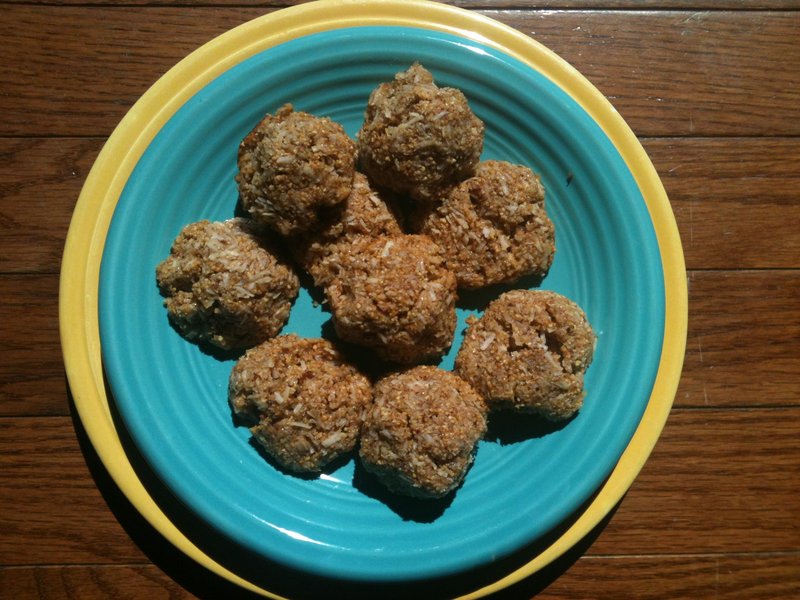As a child, Kirah Lynn Brouillette never awoke to find Cadbury Creme Eggs, Peeps or jellybeans in her basket on Easter morning. Instead, her mom filled antique baskets with books, fruit, homemade bread and cookies made with applesauce rather than sugar.
Now that she’s a new mom, Brouillette plans to follow suit and make a healthy Easter basket for her son, Oliver Richard.
“He’s only 4 months old, so I’m trying to start this family tradition really early,” Brouillette said. “The treats are going to end up being more for myself and my fiance.”
Brouillette, who lives in Westbrook, has been on a food dehydrator kick lately, and she’s turned to this kitchen tool to make raw treats for her son’s first Easter basket.
“I’m making raw magic macaroons and chocolate dipped banana chips,” she said.
The macaroons use brown rice syrup and agave syrup instead of refined sugar. Brouillette says the flavor reminds her of Caramel DeLites Girl Scout cookies.
Certified holistic health coach Maria Clark of Kennebunkport says it’s a smart move when parents like Brouillette opt to keep candy and sweets to a bare minimum.
“One thing parents can do, especially for younger kids, is to really never get them started on sugar,” said Clark. “The whole sugar piece is hard to control. Even if you think it’s just a one-time thing, it sets up triggers in the brain to want more sugar.”
Clark’s concern is based on decades of research that reveal the addictive power of sugar. For instance, a study conducted at the National Institute for Physiological Sciences in Japan found that the brain reacts to the expectation of a sugary treat in a way that makes us less able to resist temptation. Hundreds of peer-reviewed studies demonstrate that when we digest sugar, our bodies produce pleasure chemicals called opioids – commonly associated with heroin and cocaine.
Clark, who has a 10-year-old daughter and a 20-year-old son, said she is very selective about what she puts in their Easter baskets.
“I try to buy my kids one piece of really high-quality dark chocolate without milk or high-fructose corn syrup and have that last more than a day,” Clark said. “The dark chocolate definitely has some health benefits to it, especially in small quantities. It generally has less sugar.”
Instead of hiding chocolate eggs, she fills reusable plastic eggs with money or dried fruit and hides those.
“Another thing to do is introduce a piece of exotic fruit or something they’ve never seen before, like star fruit, mango or papaya,” Clark said. “Something novel like that for a kid could be a really fun thing.”
Making sure children have a high-quality breakfast before they dive into their baskets is another important Easter consideration, says Susan Fekety, a nutrition and lifestyle counselor at Healthy Living Health Care in Falmouth.
“Anticipating a sugar adventure like Easter, the rule of thumb I like to use is, first of all, you want to avoid it, and if you’re not going to avoid it, you want to protect yourself from it, and that comes from (food filled with) protein, fat and fiber,” Fekety said.
Given that eggs are traditionally associated with this ancient fertility holiday, Fekety recommends serving the classic hard-boiled variety as a breakfast treat.
“Eggs are a beautiful source of protein, which makes them a great stabilizer, especially if you’re going to be eating a lot of candy,” Fekety said.
Because conventional food colors are made from artificial colors, Fekety said anyone who plans to eat colored Easter eggs should make sure they’re dyed using natural materials, since the dye inevitably seeps through the shell.
The issue of artificial colors is one both Fekety and Clark say parents shouldn’t overlook on Easter.
“Artificial dyes and chemicals have been linked to behavioral problems in kids,” Fekety said. “If you’re going to talk about a toxic combination for a kid, it’s going to be sugar, high-fructose corn syrup and dyes.”
In 2007, the University of Southampton in the United Kingdom conducted a landmark double-blind trial that revealed a dramatic link between hyperactivity and the consumption of artificial colors and food preservatives by kids under age 10.
Because the vast majority of mainstream candies contain artificial food dyes and artificial preservatives, Easter morning can become a behavioral perfect storm. Too often, the day starts with a candy hunt, followed by a sugar high, then a sugar crash before ending with tantrums and meltdowns.
But parents who choose Easter basket treats with an eye toward health can avoid these candy-coated pitfalls.
As Fekety said, “to the extent a family’s willing to re-claim their Easter basket, they can have a different experience.”
Staff Writer Avery Yale Kamila can be contacted at 791-6297 or at: akamila@pressherald.com
Twitter: AveryYaleKamila
Send questions/comments to the editors.




Success. Please wait for the page to reload. If the page does not reload within 5 seconds, please refresh the page.
Enter your email and password to access comments.
Hi, to comment on stories you must . This profile is in addition to your subscription and website login.
Already have a commenting profile? .
Invalid username/password.
Please check your email to confirm and complete your registration.
Only subscribers are eligible to post comments. Please subscribe or login first for digital access. Here’s why.
Use the form below to reset your password. When you've submitted your account email, we will send an email with a reset code.